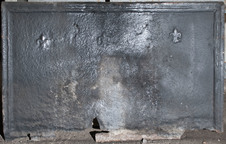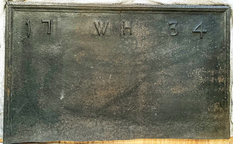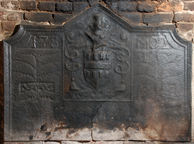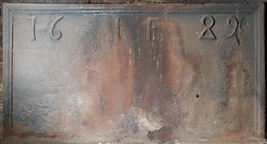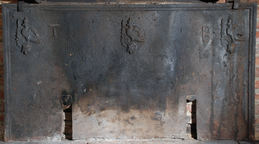-
1096
Description: Rectangular shape; ogee/cyma reversa moulded edging (top and sides); top centre, shield-shaped stamp bearing initials above date.
Notes: Two blemishes on the surface of the casting indicate that the molten iron was probably poured from two ladles simultaneously disturbing the casting sand in both locations.
Inscription: AE / 1698
- Decoration tags:
- rectangular (shape)
- cyma reversa/ogee (edging)
- carved stamps
- date stamp
- heraldic
- text
Manufactured: in 1698 in the Weald area of England.
Current location: The Manor House, Mark Cross Lane, Ripe, East Sussex, England.
- Attached to series:
- Date & initials firebacks
-
1283
Description: Rectangular shape; ogee-moulded edging; upper centred, small fleur-de-lys stamp impressed three times, the rightmost slightly higher than the other two.
Notes: A simple fireback of somewhat indeterminate date.
- Decoration tags:
- rectangular (shape)
- cyma reversa/ogee (edging)
- carved stamps
- heraldic
- objects
Manufactured: in the 17th century possibly in the Weald area of England.
Current location: Ripley Forge & Fireplaces, Northbridge Street, Robertsbridge, Salehurst, East Sussex, England.
- Attached to series:
- Fleur-de-lys firebacks
-
1236
Description: Rectangular; ogee moulding on top and side edges; symmetrical layout of date and initials; date split between left and right sides, initials in middle.
Notes: One of a series of backs dating to the 1730s and 40s using very similar sets of letters and numerals. Formerly at Yeomans, Mayfield, Sussex.
Inscription: 17 / WH / 34
- Decoration tags:
- rectangular (shape)
- cyma reversa/ogee (edging)
- carved stamps
- individual letters
- individual numbers
- text
Manufactured: in 1734 in the Weald area of England.
Current location: not known.
- Attached to series:
- 1730s-40s, date & initial series
-
700
Description: Cavetto-canted rectangle with central pediment; cyma-reversa moulded edging; central pedimented panel, fillet edged, with shield, helm, crest and mantling of the May family; on either side, an incised floral pattern of a stem and six branches, rising from a rectangular, low-relief panel of two images of horsemen; above, the inscription in low relief.
Notes: The arms of May: Gules, a fess between eight billets Or; crest: Out of a ducal coronet Or, a lion’s head gules bezanty; the same armorial stamp appears to have been used on an unnamed iron graveslab in Ticehurst church. The initials are probably those of Susanna May (c1653-1718), heir to Pashley, in Ticehurst, who had married her distant cousin, Sir Robert May, in 1686. The May family had been involved in the iron industry in the 16th and early 17th centuries, but were no longer active a century later. Incised decoration on firebacks is uncommon, the decoration probably having been incised into the pattern board.
Inscription: 17S M02
Arms: May of Pashley, Ticehurst
- Decoration tags:
- rectangular with canted top corners and triangular arch (shape)
- cyma reversa/ogee (edging)
- carved stamps
- whole carved pattern
- armorial
- text
- animals
- humans
Manufactured: in 1702 in the Weald area of England.
Current location: in private hands, Ticehurst, East Sussex, England.
- Attached to series:
- Personal armorial firebacks
-
879
Description: Rectangular; ogee-moulded edging (top and sides); at top, initials in middle, date split between top corners; large letters; straight base to number '8'.
Notes: The '8' is more typically found with the straight edge at the top.
Inscription: 16 IF 89
- Decoration tags:
- rectangular (shape)
- cyma reversa/ogee (edging)
- carved stamps
- individual letters
- individual numbers
- text
Manufactured: in 1689 in the Weald area of England.
Current location: in private hands, Westfield, East Sussex, England.
- Attached to series:
- Date & initials firebacks
-
943
Description: Rectangular shape; ogee moulded edging (top and sides); crowned falcon stamp repeated three times and spaced evenly along the top; separated initials close inside outer falcon stamps; two andiron slots.
Notes: The stamp, which was originally a badge of Queen Anne Boleyn, and first used in the letters patent of her Marquisate of Pembroke, comprises a falcon with a crown upon its head and holding a sceptre, standing upon a tree stump, from which extends a sprig of red and white roses. The badge was later adopted by Queen Elizabeth I. The probability must exist that the initials TB relate to a member of the Boleyn family.
Inscription: T B
- Decoration tags:
- rectangular (shape)
- cyma reversa/ogee (edging)
- carved stamps
- individual letters
- heraldic
- historical
- text
- animals
- plants
- objects
Manufactured: in the 16th or 17th century in the Weald area of England.
Current location: in private hands, Woodchurch, Kent, England.
- Attached to series:
- Miscellaneous stamp firebacks
- Andiron slot firebacks

